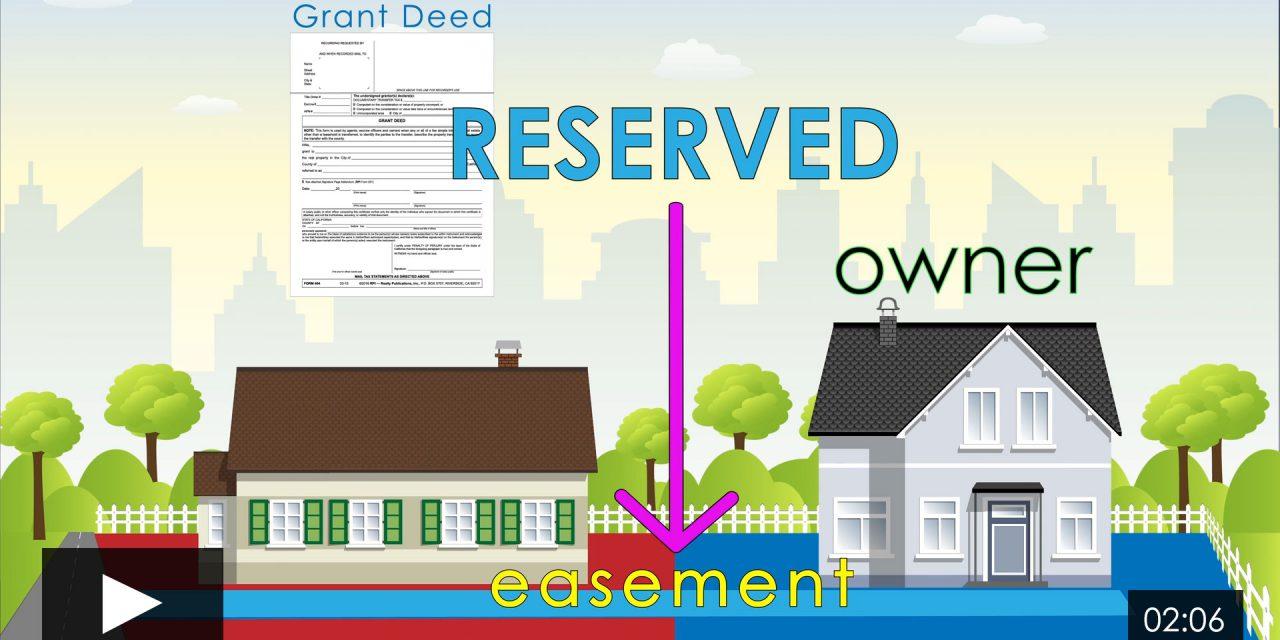This is the third episode in our new video series covering easements. The prior episode covers appurtenant easements which run with the land and easements in gross which belong to an individual or entity, plus conservation and solar easements.
This episode covers the written documents used to create an easement between benefitting and burdened properties.
Creating an easement with a writing
The basic method for creating an easement is by a writing. Any document which may be used to convey a legal interest in real estate may be used to create an easement.
An easement is created between the benefitting and burdened properties in a(n):
- easement agreement;
- will;
- grant deed;
- easement deed;
- quitclaim deed;
- lease;
- order of the court; or
- covenants, conditions and restrictions (CC&Rs).
An easement is created in a conveyance either by:
- grant; or
- reservation.
For example, the owner of adjacent parcels of real estate may sell one parcel to a buyer and further grant the buyer an easement on the parcel retained by the owner.
Alternatively, an owner of adjacent parcels may sell a parcel, and in the grant deed conveying the parcel to the buyer, reserve to themselves an easement on the sold parcel for the benefit of the parcel the owner retained.
Creative wording and certainty of purpose
Whether an easement is created by grant or reservation, uncertainties due to omissions and ambiguities in the words used to create the easement are often the cause of most disputes involving easements. To avoid uncertainties and thus disputes, the instrument creating the easement needs to fully state:
- the names of the grantor and grantee of the easement;
- a description of the parcel of real estate burdened by the easement;
- the legally described location on the burdened parcel of the easement granted or reserved by exception in a conveyance;
- the intended use for the easement; and
- whether the easement is appurtenant or in gross.
Easement or fee title conveyed by deed
The terms “reservation” and “exception” in conveyances of real estate are used to distinguish whether the legally described reservation (easement) or exception (ownership) is:
- created as a burden on the property conveyed for the beneficial use of another property, such as an easement by reservation; or
- retained from the parcel conveyed as property of the seller, an exception for land which is not transferred on the conveyance of a portion of a larger parcel.
The terms “reservation” and “exception” are often mistakenly and thus improperly used interchangeably. However, their meanings and operative effects are very different.
For example, when a grantor conveys one of two adjoining parcels they own, reserving the right to use a road on the property conveyed, the grantor has created an easement by reservation. Here, the entire parcel was conveyed while imposing a burden on that property in the nature of an easement.
In contrast, when the grantor conveys the parcel noting the description of the portion of the parcel where the road is located is excepted from the conveyance, they have not conveyed title and retains ownership to the portion of the parcel described as the road.
The difference between a reservation and an exception is apparent in the manner title insurance companies write a policy on the transfer of title.
When a parcel is conveyed reserving a road, the title insurance policy insures title to the entire parcel, then states the title is subject to — encumbered by — the easement created by the reservation.
Alternatively, when a parcel is conveyed excepting the legal description of the road, the portion of the parcel described as the location of the road is not part of the legally described property conveyed and covered by the title insurance policy. The excepted portion did not become the buyer’s property. The road did not become an easement burdening the portion of the parcel conveyed since it is located on the property cut out of the parcel by the exception. The seller retains fee ownership of the described portion containing the road since it was an exception from the parcel conveyed.
Consider a subdivider who sells a parcel of real estate to a buyer, “saving and excepting” a strip of the parcel for use as a future road.
The subdivider later claims they may build a railroad on the strip since the strip is their property, having been excepted from the legal description of the neighboring owner’s parcel.
The buyer of the parcel containing the strip claims the subdivider may not build a railroad on the strip since it is reserved as a roadway easement.
Did the subdivider except the strip and thus retain ownership to the roadway portion of the parcel sold?
No! The subdivider’s deed describing the roadway strip as an exception with the further reference to the use of the exception for roadway purposes creates an ambiguity. The ambiguity establishes an uncertainty as to whether or not fee title was retained by the subdivider.
When an ambiguity exists as to whether the seller has reserved an easement or excepted a portion of the property from the sale, the seller is presumed to have conveyed all the property and created an easement by reservation. Thus, a roadway easement exists since title to a portion of the parcel was not retained as a fee ownership exception in the conveyance. [Coon v. Sonoma Magnesite Co. (1920) 182 C 597]














